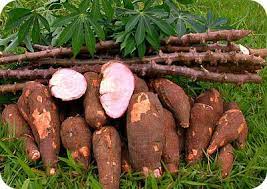

Enterprise Brief:
Cassava is a perennial woody shrub with an edible root, which grows in tropical and subtropical areas of the world. Cassava is a calorie-rich vegetable that contains plenty of carbohydrates and key vitamins and minerals. Cassava is a good source of vitamin C, thiamine, riboflavin, and niacin. The leaves, which are also edible if a person cooks them or dries them in the sun, can contain up to 25% protein.
Variety selection
There are very many local and improved varieties of cassava in Uganda. Many are susceptible to diseases. Currently recommended varieties due to cassava brown streak disease (CBSD) are NAROCAS 1, NAROCAS 2, NASE 19. These are all sweet varieties, low cyanide content and are resistant to cassava mosaic virus disease and CBSD.
| Variety | Maturity period (months) | Yield T/acre | Attributes |
| NAROCAS 1 | 12 | 25 | Large roots with brown outer skin colour, resistant to CMD and brown streak disease, sweet with low cyanide content |
| NAROCAS 2 | 12 | 20 | Roots are moderate and brown in colour, resistant to CMD and brown disease, sweet with low cyanide content. Requires fertile soil. |
| NASE 19 | 12 | 25 | Roots are moderate, resistant to CMD and brown streak disease, sweet with low cyanide content |
Growth environments
Cassava grows on poor soils, but for good growth and yield it requires friable, light textured and well drained soils containing sufficient moisture and a balanced amount of nutrients. Stress of Phosphorous in soil increases cyanogenic content in tubers.
Land Preparation.
A rough seed bed will do. Cassava responds positively to deep tillage especially in drought prone areas. Flat seedbed is a common practice Uganda. First and second ploughing will give a good seedbed.
Planting
Healthy, fresh stem cuttings (or stakes) from mature plants are best for planting. Over mature and tender stems give poor germination. If planting is delayed stems should be stored in dry, well ventilated, shaded areas away from direct sunlight. For example stems can be arranged vertically under a tree with the oldest part of the stem buried in the soil.
Planting is recommended at a spacing of 1m x 1m for optimum plant population of 4,000 plants per acre. Stake length of 25 – 30cm is recommended. Use pest and disease free cuttings which should not be bruised or which have not started sprouting, Horizontal planting of stems is a common practice and deeper planting is recommended for dry, sandy soils and shallow planting for moist and heavy soils. Plant at the onset of each rainy season for proper establishment and tuberization.
Cassava can be grown together with other crops. For example in cassava and bean intercrop, good performance is realised when cassava is spaced at 1m x 1m and beans 50cm x 20cm, both crops planted at the same time. In Cassava and maize intercrop, it is important to introduce maize 2 months after planting cassava.
Weed Control
Weeding is necessary every 3-4 weeks until 3 months after planting. Afterwards the canopy may cover the soil and weeding is less frequent. The number of times a farmer has to weed will depend on the type of weeds present and the varieties of cassava grown. Early branching varieties develop canopies which reduce weed growth. Mulching cassava, especially after planting, is helpful when growing cassava in dry areas or on slopes.
Pests and Diseases Control
| Major diseases | Casual- agent | Control |
| Cassava mosaic | Viral | Resistant variety, rogue infected plants, plant clean materials |
| Cassava Brown Streak Disease (CBSD) | Viral | Use clean planting materials, resistant variety, destruction of infected plant debris and strict by-laws to reduce spread |
| Minor disease | ||
| Bacterial wilt | Bacterial | Resistant variety |
| Major pests | ||
| Cassava green mite | Early planting, use of resistant varieties. | |
| Cassava mealy bug | Introduce biological enemy such as E.Lopez for biological control; plant Nase 1 which is resistant. |
Harvest and Post-Harvest
Harvesting can be piece meal or entire plant harvested. Avoid damaging the root tubers during and after harvest. Keep fresh tuber roots under shade or in soil if their use is extended to a period exceeding one day. Process bitter cassava varieties using manual /power graters, chippers/slicers, or a hydraulic press
Dry chips / slices in a clean dryer such as clean surface free of soil, tarpaulins, drying racks, or biomass dryers. The shelf-life of cassava is prolonged by processing it into bakery and confectionery products using a range of processing equipment available on the market. Storage technologies include cement brick silo, mud-straw and basket woven granaries and drum hermetic storage. Store in cool, dry and hygienic place.





